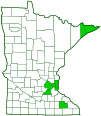treehopper
(Cyrtolobus tuberosus)
Conservation • Description • Habitat • Ecology • Distribution • Taxonomy
Conservation Status |
|
|||||||
| IUCN Red List | not listed |
|||||||
| NatureServe | not listed |
|||||||
| Minnesota | not listed |
|||||||
Description |
||
Cyrtolobus tuberosus is a large, early season, typical treehopper. It occurs in the United States from Massachusetts to Florida, west to Minnesota and eastern Texas. It also occurs in southern Ontario Canada. It is one of the most abundant and well-known species in the genus Cyrtolobus. It is less common in Minnesota, where it reaches the western extent of its range. Adults are active from April to June. They are found in and near deciduous and mixed forests where oaks are present. They feed on the plant juices of several species of large oak. In Minnesota these include black oak, bur oak, northern red oak, swamp white oak, and white oak. Cyrtolobus tuberosus is the largest treehopper in the genus Cyrtolobus. Females are ⅜″ (9 to 10 mm) in length. Males are a little smaller, ¼″ to 5⁄16″ (7 to 8 mm) in length. The body is light brown, mottled with dark brown. The head on the female is triangular, wider than long, and hairless. It is brownish-yellow, tinged with red, and pitted (punctated) with brown punctures. There are two large compound eyes and two small simple eyes (ocelli). The compound eyes are brown. The ocelli are tinged yellowish and slightly protruding. They are closer to each other than to the compound eyes. The plate on the face (clypeus) is convex with an extended, hairy tip. The antennae are short and bristle-like. They rise low on the face, in front of the compound eyes. The plate on the thorax (pronotum) is large, extending backward over the abdomen. It has a large, high, strongly compressed crest, and a short, sharply pointed tip. Viewed from the rear, it is strongly compressed. Viewed from the side, it is slightly inflated. The front corners, in the shoulder area (humeral angles), are prominent and rounded. The highest point of the crest is well behind the humeral angles. The surface is deeply and closely punctate. The compressed area is transparent with brown markings. It is brown at the base, closest to the head; it has two broad bands in the middle (middorsal); and the pointed tip is brown. The second band curves forward at the margins connecting with the first band. The wings are translucent and are brown just at the base and the tip. The legs are reddish-brown. The last part of each leg (tarsus), corresponding to the foot, has three segments. There are two claws at the tip of each tarsus. The claws are brown. The male is smaller and much darker but is otherwise similar to the female. |
||
Size |
||
Male: ¼″ to 5⁄16″ (7 to 8 mm) Female: ⅜″ (9 to 10 mm) |
||
Similar Species |
||
Habitat |
||
Deciduous and mixed forests with oaks |
||
Ecology |
||
Season |
||
April to June |
||
Behavior |
||
|
||
Life Cycle |
||
|
||
Nymph Food |
||
|
||
Adult Food |
||
Plant juices of large oaks, in Minnesota including black oak, bur oak, northern red oak, swamp white oak, and white oak |
||
Distribution |
||||
|
Sources |
|||
| 9/15/2023 | ||||
Occurrence |
||||
Common |
||||
Taxonomy |
|||
Order |
Hemiptera (True bugs, Hoppers, Aphids, and Allies) | ||
Suborder |
Auchenorrhyncha (true hoppers) | ||
Infraorder |
Cicadomorpha (spittlebugs, cicadas, leafhoppers and treehoppers) | ||
Superfamily |
Membracoidea (leafhoppers and treehoppers) | ||
Family |
Membracidae (typical treehoppers) | ||
Subfamily |
Smiliinae | ||
Tribe |
Smiliini | ||
Genus |
Cyrtolobus | ||
Synonyms |
|||
Thelia tuberosa |
|||
Common Names |
|||
None of the North American Cyrtolobus species have a common name. The common name of the family Membracidae is typical treehoppers, and it is applied here for convenience. |
|||
Glossary
Clypeus
On insects, a hardened plate on the face above the upper lip (labrum).
Ocellus
Simple eye; an eye with a single lens. Plural: ocelli.
Pronotum
The exoskeletal plate on the upper side of the first segment of the thorax of an insect.
Punctate
Dotted with pits (punctures), translucent sunken glands, or colored spots of pigment.
Tarsus
On insects, the last two to five subdivisions of the leg, attached to the tibia; the foot. On spiders, the last segment of the leg. Plural: tarsi.
Visitor Photos |
|||||
Share your photo of this insect. |
|||||
| This button not working for you? Simply email us at info@MinnesotaSeasons.com. Attach one or more photos and, if you like, a caption. |
|||||
MinnesotaSeasons.com Photos |
|||||
|
|||||

Slideshows |
||

Visitor Videos |
|||
Share your video of this insect. |
|||
| This button not working for you? Simply email us at info@MinnesotaSeasons.com. Attach a video, a YouTube link, or a cloud storage link. |
|||
Other Videos |
|||

Visitor Sightings |
|||||
Report a sighting of this insect. |
|||||
| This button not working for you? Simply email us at info@MinnesotaSeasons.com. Be sure to include a location. |
|||||
MinnesotaSeasons.com Sightings |
|||||
|
|||||

Created: 9/15/2023
Last Updated:
